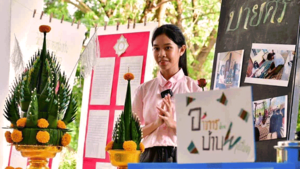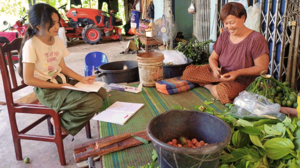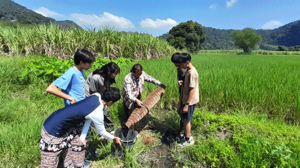Village instead of school: completely redesigning class 8
A project at the Tripat School in Thailand. A contribution by Tintin Ongpin-Montes.
Upon entering the Tripat primary school building common area one late October afternoon, I was greeted by an array of students’ works on display: handbound books opened to pages with daily journal entries, nature sketches, and scribbles; woven baskets and trays with rice seedlings; a wooden contraption that I later learned to be a simulation of a seedling threshing machine; paintings of trees, rivers and streams, and monks in saffron-colored robes; traditional Thai flower baskets and arrangements; soldier fly larvae in transparent cases; handmade posters with diagrams and descriptions of community experiences like catching fish and planting rice; a small clay diorama of a rice paddy with evergreen rice stalks to be «harvested»; and photographs of students in various community activities.

These were the outputs that class 8 had shown during their two-day presentations of their camp project. Immediately, as a viewer, I was transported to what the students had experienced, stirring a sense of awe and wonder in me.
Rethinking, redefining, and reshaping traditions
For a decade now, the school has been doing the traditional format of the class 8 Independent Project that many Waldorf schools all over the world do every year: eighth-graders choose a topic to study independently for half-a-year to sometimes a whole year, write a research report, create an artistic output, and present to the school community the lessons and insights that they have learned. It aims to develop independence, academic rigor, and love for individual learning among the students, and to generally show their readiness for the next stage of their education. However, for the academic year 2024-2025, the Tripat school class 8 teacher Nattiya Klampinij (Khru Anne), together with the middle school faculty, decided to explore a different path for the current class 8. Instead of individual projects, the class will go on a camping trip to a local Thai village, learn there, and present their experience to the school community after. Naturally, as with all new uncharted paths, questions and apprehensions arose: Will it work? Will the class still gain what they need without the usual class 8 project? The children are the curriculum. What does this look like for a post-pandemic 21st century generation of children and adolescents?
Khru Anne has observed that through the years, while the students do achieve the objectives of the projects, the engagement of previous eighth-graders has varied from being deeply engaged to expressing bouts of ennui and stress. «[In Waldorf education, we recognize] that everyone is not the same. Every child is an individual.» Khru Anne further shares, «I needed to renew, reflect, and see what really fits my class... As individuals, I see my students’ strengths and what they still need to develop. I know that I need to guide them but also allow them to grow on their own destiny.»
One of the basic principles of Waldorf education is designing lessons and activities that appropriately and holistically address the developmental needs of the students. The human being in front of us is at the core of our task as Waldorf educators. Rudolf Steiner emphasizes this when he says in one of his lectures to teachers, «Where is the book in which the teacher can read about what teaching is? The children themselves are this book. We should not learn to teach out of any book other than the one lying open before us and consisting of the children themselves.»
With a class of varying learning abilities and styles as well as unfolding personalities, Khru Anne deeply reflected on what would serve the class best. She was then reminded of the fact that her class grew up at the time of the pandemic where they experienced the isolation and struggles of learning online. «This is how they grow up,» as Khru Anne describes her class, she recognizes that there were gaps that needed to be filled and opportunities to learn together that they needed to have this time. In fact, this is the situation of many children and adolescents around the world who were impacted by growing up and learning during the pandemic. This is the «aha moment» for Khru Anne as she thought of her class who is about to transition from primary school to upper school, «They need to stay together. Learn together. But also be independent while learning with others.»
«Local life with wisdom»
In these highly individualistic times that we live in, how can we foster deeper collaborative learning among the class, while also connecting to the adolescents’ local community? How can they get to know themselves more deeply and more authentically, get in touch with their roots and cultural identity, and bring these with them as they cross the threshold from childhood to adolescence and into their own emerging Self? How to achieve all these and also meet the usual objectives of the traditional class 8 project – so that, in the end, the line «I look into the world» that the students say every morning, would truly resonate within them?
«So I searched on the internet: local life with wisdom,» Khru Anne delightfully recalls with a chuckle. Having thought of her class and their needs, she then thought of the following conditions in looking for a community suitable for the camp:
It has to be a village in Thailand where the locals live in close community with one another and where they generate their own source of livelihood, practice indigenous/ traditional crafts and ways of living.
The locals must be actively involved in the daily life of the village. This will give the students a daily, practical rhythm as they immerse in the village life, while also learning the arts and crafts and social and economic dynamics in the community.
There have to be «specialists» or «experts» in the community who can then teach the students the craft or practice that they do. This will then give the students the experience of an apprentice seeking the guidance of a mentor or an elder guide, which transcends the usual classroom/ academic experience.
The village must be a nature’s haven so that the students will experience being surrounded by nature and its beauty every day. Khru Anne also considers the specific needs of students, e.g., one boy needs to have a lot of space for him to walk around, feel free.
Ban Pha Biad in Chaiyapum is located in the northeastern part of Thailand. The way of life of the people here is tied to the water – its springs, streams, and river. They make use of traditional wisdom and technology in harnessing the water and sustaining their livelihood.
«Here, the students learned that nobody owns the water. It is not about ownership or property or not about the money,» Khru Anne explains. Because of this, the people’s lives are intricately tied to one another and they feel responsible for everybody – from grandchildren to grandparents, everyone shares and works together in the community. In a globalized, consumerist, digital yet divided world, working for the benefit of the whole community is a valuable lesson for the class.
Learning together – deepening individually
Together with three other teachers, Khru Anne accompanied Class 8 in immersing themselves in village life for nine days. Their activities included the following:
Cooking local menu like the khao porridge
Doing the rice offering
Climbing the betel palm trees and picking betel nuts
Organic farming
Cultivating black soldier fly larvae to help promote zero waste in the village
Basket weaving
Tree planting
Volunteer work - cleaning in the temple areas
Practicing «Tu-num» for sharing water

Making fish traps
Working and playing with the children at the village school
Forest bathing and walks to the spring
Clearly, it was important for the class to experience the genius loci or spirit of the place, which is intrinsically connected to the cultural identity of the students. Khru Anne also adds, «This village is like our school. Everybody is welcome. There is warmth. Everybody knows everybody. They all work together, share, and show responsibility for the whole village.» The value of relationships and interconnectedness with one another was evident in the camp’s vision.
«We stayed in the village for eight nights and nine days. For the first six days, the whole class learned the same things together. For example, they all did basket making, fish traps, planting. We also had a common learning space, like the temple. Then on the seventh night, I asked them to choose an activity that they wanted to learn more about for the next two days.»
Every day, the students went along the health-giving rhythm of the village people: doing the same practical and purposeful tasks–if one fails to fulfill their tasks, then the rest of the community would be affected. They helped prepare and cook their meals, learned about traditional processes like fish catching and betel nut harvesting; had dialogues with the monks and elders in the village and learned about stories of growing up in the community. «Life in the village is slow; life is not lived in a rush. Most of the students are familiar with city life so this is different for them.» In a way, the village people were the students’ teachers, the daily life the lessons, and the village itself the classroom – what a way to learn! Indeed, during the presentations after the camp, most of the students marveled at the fact that the people of Ban Pha Biad were open, kind, and had a joy for life.
Aside from these daytime activities, the class would gather together with the teachers after dinner. They would review the day, have conversations about what they learned, what touched them the most, how they did and what else they could do better for the next day. When the task of choosing an activity for themselves was announced, they were encouraged to choose what they truly wished to concentrate on. «So after the group experience, now they have their own individual experience. I wanted them not just to learn, but to really understand.» They were in charge of choosing their own «wisdom place», as Khru Anne described it – an exercise on autonomy and agency.
This is how they need to grow up
«Time is so quick, I want more days to stay.» As teachers, we know that when students learn to be engaged in their head, heart, hands, they themselves will show this. In reshaping the ways we teach, in ways that go beyond the so-called Waldorf traditions in the curriculum, we are able to meet the students where they truly are in their development, and in the reality and times that they live in.
In this new «Class 8 project» experience, the students learned how to be, how to grow up, so to speak. They did not learn through academic research only, but through something more enriching, meaningful, real, and profoundly human. To this, Khru Anne adds, «I think this was a valuable experience for them. It taught me a lot, too. We learned about people’s lives, nature. They learned about what it means to have money that is meaningful. This was real for them because they lived it.»
By working together, they gained new knowledge about their own culture, practical life and technology. They discovered insights about themselves and others, immersed themselves in a community that lives in a culture of care and kindness, as well as ethical responsibility for the people and the environment.
With the school’s and the teachers’ willingness, flexibility, and creativity to reshape education practices, the class was accompanied in their journey through the last year of their primary education in a meaningful and authentic way, ushering them fully into the threshold of adolescence.
Tintin Ongpin-Montes
